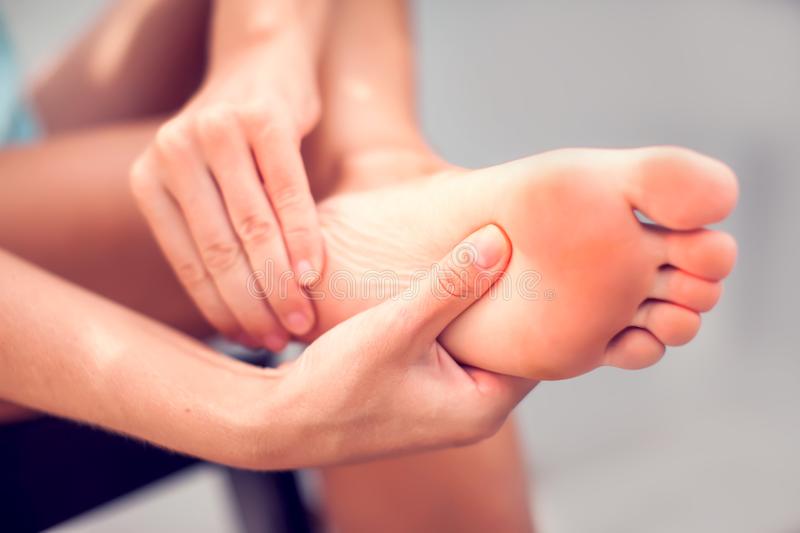Pain is a common symptom that triggers a distressing signal in the brain. It is associated with various pathologies and tells your brain that your body is in danger. It is related to an area of the brain called the amygdala, which processes the emotional response we always experience with pain. Thus, pain is not a simple perception. It is linked to strong emotions such as anger, stress, and anxiety. That’s why patients with pain in the arch of the foot suffer a great deal when they are walking and continuously feeling pain.

You would understand the pain that is triggered by walking if you have lesions in your feet. However, in some cases, patients may also feel pain in the arch of the foot at rest. Thus, the question remains, why does pain in the arch of the foot occur at rest?
Causes of pain in the arch of the foot
Various causes can trigger pain in the arch of the foot. It is a common problem, especially in athletes, because they usually go through injuries, overuse of the articulations, and may even have structural deformities due to fractures and lesions. The arch of the feet is the area located from the base of the toes to the heel, and it is mostly used in the process of walking and running.
The arch of the foot works as a cushion. It absorbs shock forces when they are applied from both sides, bearing all the weight of the body. As it is, the arch of the foot provides stability to the body and our movements and contributes to our balance during gait.
Common causes of pain in the arch of the foot include:
- Weight gain: In cases of obesity, the whole weight of the body reaches the foot arc, and it causes pain in the foot that may persist at rest.
- Aging: As we age, the strength of the tendons and muscles of the arc decline and wear down, causing foot pain during gait.
- Overuse injuries: In older adults and any other age, overuse injuries of the muscles and tendons of the foot result in foot pain. In some cases, this is caused by structural lesions in the muscles, tendons, and articulations. In other cases, it is due to neurological conditions affecting the nerves that supply the base of the feet or the heel.
- Plantar fasciitis: It is the inflammation of the plantar fascia when there is too much pressure upon the area. The conditions listed above may contribute to plantar fasciitis, and it is a type of foot pain triggered by walking and running. However, it is so severe that it persists at rest for a long time.
- Peripheral neuropathy: This nervous disorder is common in diabetes, cancer, shingles, and other medical conditions. It typically causes numbness of the foot, but may also cause foot pain at rest.
- Plantar Fibroma: This can be a very awkward problem because it is located in the arch of the foot. If you can feel you have a tough fibrous knot then you may have this conidtion. SEE VIDEO BELOW for more Plantar Fibroma.
Diagnosing the cause of Sharp foot pains
When you visit a doctor to report this complaint, he will make his diagnosis based on the physical examination and through radiological investigations. Physical examination should be done to locate more accurately the painful area, where it starts, and where it is radiating to. Other factors include signs of inflammation such as redness and warmth.

Since peripheral neuropathy and other nervous conditions should be ruled out, your doctor will possibly require an examination of the normal reflexes of the body as well as examining the coordination of body movements and the tone of your muscles.
After performing a thorough physical examination, confirmatory findings may include imaging techniques such as X-rays to see if there is any bony involvement or any abnormal bone formations, as in spurs growth. MRI scans and CT Scans are helpful to confirm tendon or ligament injury, as well as spine involvement.
What can you do if you have foot pain when resting?
Medical treatment is fundamental, and various painkillers and anti-inflammatory drugs can be used to speed up pain relief. However, these drugs have side effects such as stomach upset, bleeding, and liver toxicity, and they may not be the best option for chronic patients.
Thus, the best way to manage this type of pain is at home by keeping the following things in mind.
- Maintain a healthy weight: Excess weight can be the leading cause of foot pain, but even if you have a bigger problem, overweight and obesity will make it even worse. Thus, try to maintain a healthy weight. This will reduce the stress put on your joints and reduce the imbalance in your gait.
- Rest appropriately: This is probably the most important advice given by medical practitioners to all patients complaining of foot pain. In plantar fasciitis and other overuse injuries, the body needs some extra time to rest and recover properly for the upcoming activities. If you exercise a lot in old age, reduce your exercise time or increase your resting time. If you have a fractured foot, follow the instructions given by your doctor and wait the appropriate time before resuming your physical activity.
- Use your braces: Ankles braces can be used to support the heel and ankle joints and reduce the tension over the ligaments and tendons. This type of braces is a common prescription by doctors, and it can be very useful to relieve pain. However, remember that this only works if you use them continuously.
- Exercise daily: Excessive exercise is not a good idea, but a sedentary behavior does not help, either. Not exercising appropriately may contribute to weakening the muscles and the connective tissue, predisposing to foot pain.
- Home remedies with temperature: Ice packs are very helpful to relieve arch pain. It can be applied with a towel and alternated with warm compresses to stimulate blood circulation.
- Wear supportive shoes: Shoes with soft soles are usually preferred, and high heel shoes should be avoided in cases of heel pain.
References:
Benvenuti, F., Ferrucci, L., Guralnik, J. M., Gangemi, S., & Baroni, A. (1995). Foot pain and disability in older persons: an epidemiologic survey. Journal of the American Geriatrics Society, 43(5), 479-484.
Buchbinder, R. (2004). Plantar fasciitis. New England Journal of Medicine, 350(21), 2159-2166.
Huffer, D., Hing, W., Newton, R., & Clair, M. (2017). Strength training for plantar fasciitis and the intrinsic foot musculature: A systematic review. Physical Therapy in Sport, 24, 44-52.
